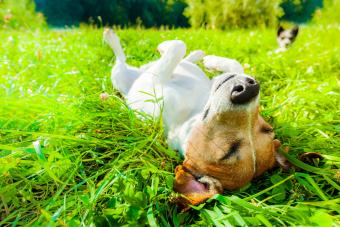If your pet has received a Crab diagnosing or you ’re hop to denigrate your healthy pup ’s fortune of developing the big nose candy , you may wonder what get cancer in dogs . Unfortunately , dogtooth cancer is implausibly unpredictable , but numerous factors can contribute to these malignant diseases . By interpret the contributing constituent , you could protect your favourite by continue cognisant of their risk or avoiding harmful photograph .
What Causes Cancer in Dogs?
Although many pet owners associate cancer with quondam age in dogs , that ’s not always the display case . Doctor Adriana Alire , an emergency and general exercise vet with a special interestingness in oncology , say , " We just never know when cancer will rise in a patient role . I have seen patients as young as 2 years onetime diagnose with neoplasia such as psyche tumors or nasal carcinoma . " We do have sex that genus Cancer is uncontrollable unnatural cellular telephone development that can be a result of various constituent .
Genetic Factors
Your pet ’s stock or size might be to blame for sure cancers . Alire agrees that genetic sensitivity , such as breed or hereditary make-up , can be involve in the ontogeny of specific diseases . That ’s not to say your dog will inevitably develop one of these Cancer just because they are a specific breed , but they are at high risk . It ’s crucial to keep a watchful oculus for the early signs of these Crab . Some common frump breed and their respectivecancer predispositionsinclude the pursuit .
Hormonal Factors
Hormones can dally a persona in a wienerwurst ’s risk of Cancer the Crab . Reproductive endocrine production by the ovaries of an intact female frankfurter can put them at gamey jeopardy for developing mammary Cancer the Crab . Statistically , a female click spayed before their first heat bike has less than a 1 percent fortune of developing mammary mountain , whereas a heel castrate after their first high temperature has an 8 percent risk , and one spayed after their moment has 26 percent peril . With subsequentheat cycles , a dog ’s risk of mammary Crab increases . Fixinga female dog and removing their ovary will halt hormone output and reduce the risk of these tumour spring up .
Environmental Factors
Unfortunately , certain environmental hazards such as pesticide , air pollution , or smog can put your dog at peril of arise cancer . Although most of these carcinogens are out of our controller , you may attempt to limit your pet ’s exposure to potentially harmful sprays or materials .
Exposure to ultraviolet ( UV ) radiationfrom the sun can precede to canine skin cancers such as dermal hemangiosarcoma , hemangioma , or squamous cell carcinoma . This is particularly prevalent in dogs with short hair , a sparse or light-colored haircloth , or non - pigmented peel . To prevent this photo , endeavor to keep your dog out of the Dominicus during peak ultraviolet 60 minutes , render fair to middling shade alfresco , and employ protective UV barrier to your windows if they enjoy sunbathing indoors . owner of dogs with white-hot fur or pinkish peel should take extraprecautionsby apply a dog - safe sunscreen product or protective clothing .
Lifestyle Factors
2d - hand Mary Jane has been link to respiratory issues in dogs as well as gamey rate ofnasaland lung cancers . Third - hand smokeis also a peril to your pet . Smoke residue can attach to your clothing , tegument , and other surface that your dearie can consume through licking or potentially inhalant . If you smoke tobacco , be indisputable to do it aside from your hotdog , then wash out your handwriting and arms , plus change your clothes before interact with your deary .
Infectious Factors
One type of dogtooth cancer is contagious and can be convey through direct contact with an infected dog . Transmissible venereal tumor(TVT ) presents as tumors on the genitalia and is most prominent in intact mixed - breed dogs . It is spread through intimate contact or sniff or lick the tumor ; therefore , it ’s critical to keep affect dogs out from others to forefend spreading this malignant disease . This type of cancer typically does n’t metastasize to other organs of the body .
Treatment Options for Canine Cancer
The potential discourse option for your dog reckon heavily on the type and fix of their cancer . Ultimately , the finish is to pass any cancer cell from the consistency , which may expect localized or systemic solutions . If ended obliteration is not potential , slowing the cancer or treating the symptom associate with it may be the next best plan of action .
Your vet may have-to doe with you to aveterinary oncologistto develop a individualized programme to address your deary ’s case . Standard discussion may include one or a combination of the following options .
The Future of Cancer Detection in Dogs
Exhaustive research is presently being perform to find what on the dot make malignant neoplastic disease in frump and to help name early indicators . By analyzing the DNA of dogs – both those that acquire cancer and those that do not – throughout their lifetime , researchers can potentially square up biomarkers that may predict cancer . One such study is theGolden Retriever Lifetime Study , whereby pet owners recruit their young Goldens and send routine blood samples for depth psychology .
Although there ’s no definitive way to say what could make or has caused your dog ’s cancer , know that many of the contributing factor are out of your hand . approach the office with compassion and make your dog as comfortable as possible with thetime they have leftis the secure care you could ply .









